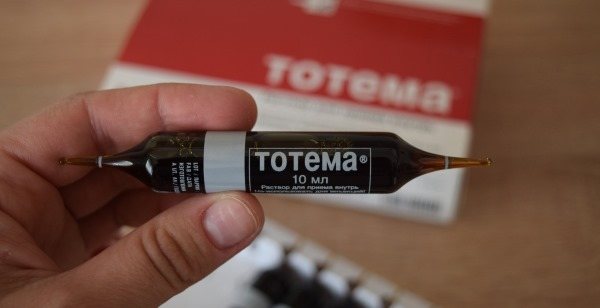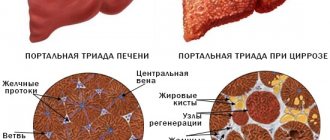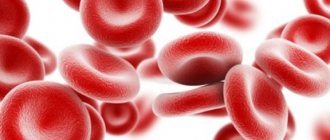Mean platelet volume (MPV, mean platelet volume) is one of the indicators of the platelet component of the hemogram, a qualitative and quantitative blood test. If it is elevated, then this can be both a variant of the norm and a sign of disease.
An increase in MPV indicates that there are many “young” platelets in the blood, since they have a larger volume. In adults and children, the normal values of this indicator differ. It serves as a useful diagnostic tool to identify the cause of thrombocytopenia and thrombocytosis (increased and decreased platelet counts, respectively).
What test determines the level of platelets in the blood?
The average platelet volume is increased in adults in several cases. Its determination is made as part of a general blood test. Platelet counts are calculated using automatic analyzers.
To obtain them, capillary blood is taken from the patient from a finger (less often from a vein). At the same time, the total number of platelets is counted, their distribution by volume, and the proportion of whole blood is calculated.
Platelets are fragments of bone marrow cells and their activity affects blood clotting. Their size can vary between 2-4 microns. Normally, mature cells should predominate (more than 90% of the total).
In cases where there is a need for enhanced platelet reproduction in the body (for example, when they are removed from the blood under the influence of antiplatelet antibodies or during massive blood clotting), the number of “young”, larger cells increases. As a result, the average platelet volume increases.
MPV control: prevention
To avoid the development of deviations, experts recommend adhering to preventive measures. For this purpose, it is necessary to follow generally accepted rules:
- regularly monitor platelet levels in the blood;
- promptly treat pathological processes;
- maintain the condition of chronic diseases;
- do not self-medicate;
- eliminate viral diseases in a timely manner using medications prescribed by the attending physician;
- maintain a diet;
- drink enough liquid.
Attention: with a sharp decrease in body weight, constant fatigue and systematic nosebleeds, it is advisable to seek help from a medical institution.
The main indications for immediate examination are: change in skin color, causeless formation of hematomas and rapid heartbeat.
A blood test for MPV can help identify problems with blood clotting and determine the average platelet volume. What indicators are included in the reference values and what does their increase and decrease indicate?
MPV performance standards
MPV is measured in µm3 or fl (femtoliters). This figure increases with age. A high MPV value indicates that a person's blood has more large platelets and is producing too many of them.
Large cells are young, meaning they have recently been released into the bloodstream from the bone marrow. Small ones have been circulating in the bloodstream for several days.
The MPV indicator itself cannot serve as the sole criterion for diagnosis. For example, an overall low platelet count and high MPV may be due to the fact that “old” platelets are being destroyed too quickly, and the bone marrow is trying to make up for their deficiency with new, larger cells.
In adults
The normal average values of this indicator for adults are shown in the table:
| Patient group | MPV, fl |
| Women | 7-11 |
| Men | 10-11 |
| People over 70 years old | 9,5-10,6 |
As can be seen from the above data, MPV in women varies within wider limits than in men. This is due to the fact that during menstrual bleeding, a change in platelet concentration occurs to facilitate endometrial shedding.
In children
In healthy newborns, the average normal MPV level is lower – 5.7±1.2 fl. The overall distribution of platelets by volume should be about 19%, and the platelet level should be 285±63 thousand in 1 μl. This value is associated with the immaturity of the hematopoietic system. It gradually increases with age.
During pregnancy
The MPV level increases during pregnancy, which is due to the body's natural defense against possible bleeding and fetal rejection.

Mean platelet volume (MPV) during pregnancy
Platelet indices also vary depending on the week of pregnancy. The normal value during this period may differ from the above by 10-20%.
Normal index values
The norms are calculated for each indicator in the blood test:
- For MPV from 7 to 10 femtoliters;
- For PDW from 15 to 17%;
- For PCT from 0.108 to 0.282%.
Each index can be raised or lowered. The cause is various factors, including diseases. You need to know that various actions unrelated to ongoing diseases can lead to changes in each of these indicators and thus the blood test will contain deliberately false results.
Reasons for the increase in MPV
High levels of MPV can be caused by both physiological reasons (described below) and pathological ones.

The latter include:
- systemic diseases (systemic lupus erythematosus);
- blood pathologies;
- endocrine disorders;
- infectious diseases;
- inflammatory processes;
- burns, injuries;
- some hereditary diseases.
Endocrine diseases
The average platelet volume is increased in adults with type 2 diabetes mellitus. This indicator is used as a prognostic indicator to determine the level of risk of microvascular complications in patients of this group.
In diabetes mellitus, platelet activation occurs, and the incidence of atherosclerosis is 2-4 times higher compared to healthy people. However, with good glycemic control, the development of such complications can be delayed.
Another endocrine disorder in which high MPV is observed is hyperthyroidism - increased production of hormones in the thyroid gland, which affect all types of metabolism in the human body. With this disease, the production of blood clotting factors is disrupted and the risk of cerebral thrombosis increases.
Early postoperative period
An increase in MPV levels in the postoperative period, after injuries and burns, is associated with significant blood loss. In order for the wounds to close, more platelets are needed. Therefore, the production of “young”, larger cells is activated in the bone marrow, which is what causes this phenomenon.
MPV usually returns to normal by the time you are discharged from the hospital. In the case of burns, this occurs by the time the wounds are completely closed.
Hereditary diseases
The average platelet volume also changes in some genetic diseases.
It is elevated in an adult or a child in the following cases:
- Giant platelet syndrome (Wiskott-Aldrich syndrome) . This disease mainly affects men (1 case per 250 thousand newborn boys). It manifests itself in the form of frequent bleeding, which is the main cause of death in patients. The diagnosis in most patients is established by 1.5 years after birth. In some patients, the disease is mild, so it may not be detected for a long time.
- Bernard-Soulier syndrome. In this disorder, platelets are unable to adhere to damaged blood vessel walls, making it difficult for wounds to heal normally. Genetic deviation most often occurs in consanguineous marriages (both among men and women).

- Mediterranean macrothrombocytopenia. This disorder is also characterized by bleeding, but more moderate than in previous cases. Simultaneously with the increase in platelet size, there is a decrease in their total number in the blood.
- May-Heglin syndrome. This is a rare genetic disorder associated with purpura and bleeding (from the nose, in the mouth, in the form of bruises under the skin, heavy menstruation in women). In this case, platelets reach gigantic sizes, and their structure is not disturbed.
- Epstein syndrome. Such patients are characterized not only by impaired hematopoietic function, but also by deafness and kidney pathologies. The prevalence of the disease is 1 case per 300-400 thousand newborns.
- Sebastian syndrome. Its features are hearing loss, cataracts, and kidney damage.
Genetic disorders are associated with qualitative defects in platelet production and maturation. Such patients receive mainly supportive and symptomatic treatment.
Tumors
When platelets in the bloodstream collide with substances produced by the tumor, their activation may occur. However, an increase in MPV is not the only sign of a tumor. If there is a family history of cancer, the doctor should order additional tests to rule out this diagnosis.
The localization of the tumor can be very different: lungs, endometrium in women, mammary gland, kidneys, stomach, colon and other organs.
Inflammation
The average platelet volume is increased in adults with the following infectious and inflammatory processes:
- viral respiratory diseases;
- sepsis;
- HIV;
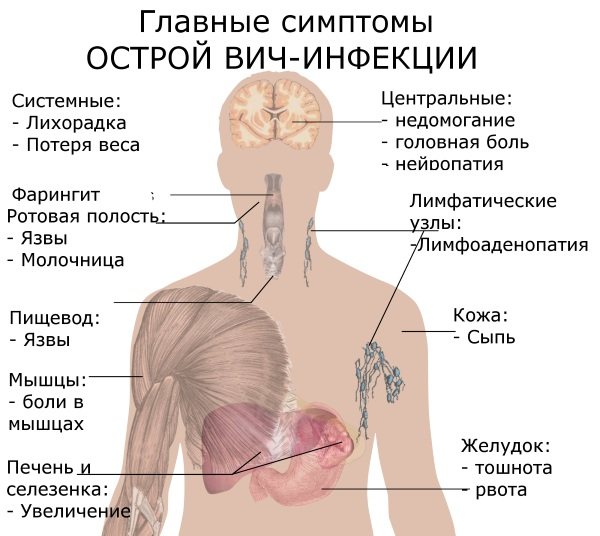
- Epstein-Barr virus and other systemic inflammatory reactions.
The release of proinflammatory cytokines stimulates platelet activation. After treatment of the underlying disease, the MPV level returns to normal.
Malignant blood diseases
The formation of platelets is also influenced by malignant blood pathologies, such as chronic myeloid leukemia. This is a tumor disease in which the degeneration of stem cells, which give rise to all blood cells, occurs. The disorder can occur due to exposure to radiation, infections and toxins.
The prevalence of the pathology is relatively low - about 1 patient per 100 thousand adults. Most often it is diagnosed at the age of 50-59 years. At the initial stage, symptoms may be completely absent for a number of years.
Subjective factors
Other reasons for increased MPV levels may include:
- living at high altitudes above sea level;
- smoking and alcohol abuse;
- intense physical activity;
- taking oral contraceptives and certain medications that enhance bone marrow activity.
What are platelets?
Platelets (PLT) are cells designed for the stable functioning of the body's blood vessels. The site of PLT formation is the bone marrow. The method for determining blood platelets is a general blood test.
Blood plates perform a number of functions:
- Hemostatic – for skin lesions, PLTs are combined into large and small groups to stop bleeding.
- Nourishing – in case of wounds or damaged skin, they nourish the inner surface of blood vessels.
- Protective – can independently absorb small bacteria (phagocytosis).
- Transport - capable of delivering various substances to the body, for example, serotonin.
- Strengthening - help maintain the density of the walls of blood vessels to reduce their premature destruction.
The optimal PLT level is 150-400*109/l. These indicators depend on the patient’s age, as well as gender and general condition of the body. In addition, platelet values change by 10-15% throughout the day.
In medicine, it is worth distinguishing 5 forms of blood platelets, namely:
In addition, PLTs go through 3 stages to stop bleeding, namely:
- Adhesion is the adhesion of blood platelets to the walls of a damaged vessel.
- Activation – enlargement of cells in order to increase the area of interaction.
- Aggregation is the sticking together of PLT with the help of fibrinogen (through receptors).

Signs confirming a high level of platelets in the blood
Depending on the underlying cause, patients may present with various external signs.
Thus, the following symptoms are characteristic of diabetes mellitus:
- increased amount of urine excreted;
- constant feeling of thirst and hunger;
- loss of body weight despite a good appetite as a result of increased energy metabolism;
- skin itching;
- general weakness and headache.
The following symptoms are observed in hyperthyroidism:
- increased sweating;
- weight loss with good appetite;
- an increase in the size of the thyroid gland;
- tachycardia (increased heart rate);
- arrhythmia (heart rhythm disturbance);
- diarrhea, abdominal pain, sometimes vomiting;
- menstrual irregularities and impotence;
- general weakness, increased fatigue;
- in the severe stage – liver enlargement and pain in it, jaundice.

Precancerous conditions are characterized by chronic inflammatory processes, for example:
- chronic gastritis (stomach cancer);
- bronchitis (lung cancer);
- hepatitis and cirrhosis (liver cancer);
- erosion and leukoplakia (cervical cancer);
- dermatitis after ultraviolet or radiation exposure (skin cancer).
With chronic myeloid leukemia, symptoms such as:
- general weakness;
- increased sweating;
- chills;
- joint pain;
- weight loss;
- increased bleeding;
- hemorrhagic rashes on mucous membranes and skin;
- enlarged liver or spleen.
Since the above signs are not specific, additional research is necessary to make an accurate diagnosis. As preventive measures, you should undergo regular medical examinations on time and prevent inflammatory diseases from becoming chronic.
Large platelets
The percentage of enlarged PLTs relative to normal-sized cells is reflected by the P-LCR, which stands for large platelet ratio. The normal P-LCR value among patients of different ages and gender is 13-42%.
With a significant decrease in this indicator (below 10%), serious diseases develop, such as: leukemia; kidney inflammation; chronic nephritis (kidney pathology); malaria.
An increase in P-LCR leads to thrombus formation, as well as to the appearance of pathologies such as: helminthic infestation; leukemia; leukemia; cancer; viral infection.

Possible complications
The average platelet volume is increased in an adult in the presence of disturbances in the hemostatic system. The most serious complications are bleeding and deep vein thrombosis (including the pulmonary artery).
Impaired blood clotting, for which platelets are mainly responsible, leads to the development of hemorrhagic syndrome. It can manifest itself both in a mild form, in the form of petechiae (small subcutaneous hemorrhages), and in a severe form - hemorrhages in the brain, ending in death.

Deep vein thromboembolism is also associated with high mortality. Blockage by blood clots can occur in various areas - in the veins of the lower extremities, lungs, pelvic organs (damage to the kidneys, liver) and heart. In this case, tissue infarction occurs. The risk of this complication is especially high in severe injuries, burns and in the postoperative period.
How is blood drawn?
No special preparation is required; all you need to do is take a fasting blood test from the capillaries of your finger (usually the ring finger) or take material from a vein.
Before this, you should not eat spicy, salty, pickled foods, smoked or dried foods. If possible, you should postpone taking medications and coordinate this step with your doctor in advance. Taking venous blood allows for a clearer interpretation, but a general analysis will be sufficient for diagnosis. If you need to retake the material, it is recommended to take the analysis at the same time of day as the primary one.
The material for studying platelet indicators immediately begins to be processed (modern automatic analyzers are more often used) and within 2 days you can get the finished result.
Treatment
Treatment tactics depend on the underlying disease for which this change in the blood is diagnosed. For physiological reasons, therapy is not required.
To establish a diagnosis, the doctor prescribes additional tests:
- biochemical and hormonal blood analysis;
- general urine analysis;
- Ultrasound of the abdominal organs;
- ECG and others.
Drugs
The main medications for treating conditions associated with elevated MPV are listed in the table below.
| Name | Purpose | Average dosage for adults per day | Average price, rub. |
| Antiplatelet drugs
| |||
| Clopidogrel | Decreased platelet activation and an increase in their average size without changing their absolute number | 75 mg | 670 |
| Plagril | 400 | ||
| Antifibrinolytic drugs | |||
| Desmopressin (synthetic analogue of the hormone vasopressin) | Preventing the destruction of blood clots and stopping severe bleeding | 0.1-0.2 mg 1-3 times a day | 1500 |
| Aminocaproic acid (5% solution for infusion) | 5 g until bleeding stops completely | 60 | |
| Medicines to control heavy menstrual bleeding in women | |||
| Levonorgestrel | Reducing blood loss during menstruation | According to the dosage regimen (daily) | 400 |
| Intrauterine device "Mirena" | — | 13 000 | |
| Iron supplements
| |||
| Totema | Treatment of iron deficiency anemia with heavy bleeding | 2-4 ampoules (100-200 mg iron) | 500 |
| Maltofer | 1-3 tablets (100-300 mg iron) | 300 | |
For severe, uncontrollable bleeding that occurs due to a bleeding disorder, platelet transfusion is indicated. This procedure is also performed after surgery. For such patients, taking Aspirin and NSAIDs (Ibuprofen, Naproxen and others) is contraindicated, as they can worsen symptoms.
Since all these drugs have side effects, their independent use is not allowed. A preliminary consultation with a doctor is required.
Diet
To reduce the risk of complications, you must adhere to the following dietary recommendations:
- Drink plenty of water and reduce the amount of table salt. Salty foods provoke an increase in blood pressure and the displacement of blood clots.
- Fatty meats and dairy products with a high percentage of fat content should be excluded from the diet. Instead, use lean meats and fish, vegetables, fruits, and cereals.
- It is also not recommended to consume spicy, smoked food and canned food, alcohol, coffee and cocoa, yeast baked goods and sweets with fatty creams.
- Omega-3 and omega-6 unsaturated acids, which are found in significant quantities in fish and seafood, contribute to the dissolution of blood clots.
- To restore iron levels, you can eat liver dishes (1-2 times a week). Preference should be given to steamed or boiled products.
If you have concomitant diseases, there may be other dietary restrictions, the need for which should be consulted with your doctor.
Traditional methods
To dissolve blood clots in folk medicine, the following recipe is used:
- Add 15 drops of horse chestnut tincture to 150 g of grapefruit juice.
- Add ½ tbsp. l. tincture of celandine, kept in vodka for 1 week (17% solution).
- Take this remedy regularly, with a break of 1 day every 6 days for 1 month.
- Then take a 2 week break.
- Continue treatment according to the same regimen, there should be 3-6 courses in total.
The following methods are used as hemostatic agents for heavy menstruation in women:
- Barberry tincture. 2 tbsp. l. crushed leaves of the plant pour 1 tbsp. boiling water and leave for 1 hour. Take 1 tbsp. l. 5 times a day.

- 1 tbsp. l. Pour a glass of boiling water over chopped nettle herb and keep on low heat for 15 minutes. Strain and take 1 tbsp. in a day.
- 1 tbsp. l. burnet roots pour 1 tbsp. boiling water, leave for half an hour. Drink 3 times a day.
The average platelet volume is used in laboratory practice for the diagnosis and control of various diseases that are associated with the blood and hematopoietic system.
If MPV is elevated in an adult, this may indicate serious pathologies that require additional diagnosis and treatment, since the platelet component of the blood is responsible for such important characteristics as clotting.
Treatment of platelet abnormalities
It is important to understand that a high average platelet volume is not an independent disease, but only a concomitant symptom of the underlying pathology. Therefore, before starting treatment, you need to find out the reason for the increase.
If there is a slight deviation from the norm, you can correct the situation with proper nutrition. It is important to adhere to the following principles:
- Maintain drinking regime. You need to drink at least two liters of clean water per day.
- Replace animal fats with vegetable fats: preference should be given to olive and flaxseed oils.
- Replace fatty meats with dietary ones - rabbit, turkey.
- Eat lean fish.
- Eat foods that thin the blood: blueberries, cranberries, tomatoes, ginger, green tea.
Hormonal contraceptives, any alcoholic drinks, diuretics are strictly prohibited - they contribute to blood thickening and will only aggravate the problem.
Drug treatment is used to reduce platelet levels. Preparations containing acetylsalicylic acid are used.
Important! With an increased platelet volume, self-medication is unacceptable. Be sure to consult your doctor. He will find out the cause of the pathology and prescribe suitable medications.

Proper nutrition is the key to successful treatment of elevated platelets
To eliminate the problem, it is important not only to reduce the increased platelet volume, but also to influence the underlying disease that provoked it. Here are some examples:
- Thrombocytosis . The platelet level is elevated, so all efforts are aimed at lowering it. A diet and proper drinking regimen must be followed. But it is important to understand that thrombocytosis is just the tip of the iceberg; it can be caused by another disease. The doctor’s task is to find the root cause and choose the right treatment.
- Thrombocytopenia . In this condition, platelet levels are low. To treat the pathology, medications are prescribed that prevent the destruction of platelets, strengthen the walls of blood vessels and have a hemostatic effect.
- Diabetes . It is not completely curable, but can be corrected with a special diet, and in severe cases, insulin injections are used.
- Atherosclerosis . Treatment is aimed at reducing blood cholesterol through diet and medications.
An annual preventative medical examination will help you notice the problem in time and take steps to eliminate it. An increase in the average platelet volume is a serious pathology that can lead to dire consequences, including death. Therefore, timely measures will help maintain health and save life.
If you find yourself with similar symptoms, then contact your doctor, do not self-medicate or use folk therapy.
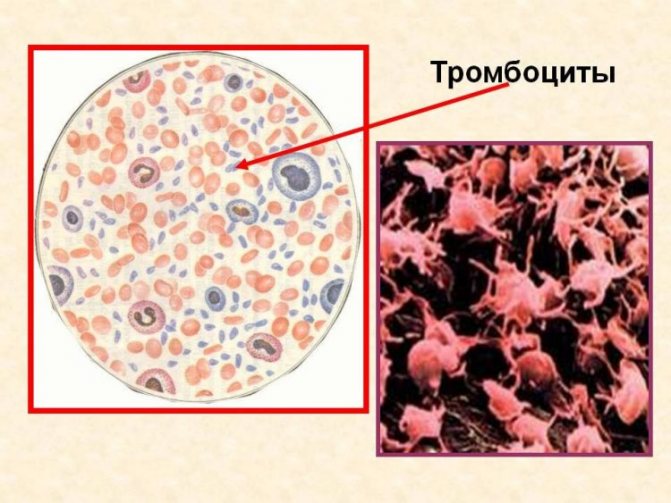
The photo shows what platelets look like in blood plasma, among erythrocytes and leukocytes.
Preventive measures
In the early stages of the disease, patients can prevent its progression in the future. To do this, it is necessary to normalize the level of physical activity, that is, to abandon active training. It is permissible to perform only light warm-up and morning exercises. Patients with low platelet counts are advised to choose an office-type job. The basis for good health in thrombocytopenia is adequate sleep and proper nutrition. Adults need to sleep at least 9 hours a day.
As for the diet, women and men should avoid eating pickles, pickled foods, spicy and smoked foods. The use of alcohol and tobacco products, sugar, and hot seasonings is unacceptable. The emphasis in the diet should be on food of plant origin. Doctors do not recommend taking antibiotics and anti-inflammatory drugs such as Aspirin or Analgin during an exacerbation of the disease. To maintain the functioning of the body, you need to take vitamin and mineral complexes.

Platelet aggregation
Aggregation is the gluing of platelets together to form a plug (closes the wound). So, thanks to aggregation, the blood stops within 15 seconds. Therefore, the main function of aggregation is to stop bleeding by protecting the damaged vessel.
Important! The normal level of aggregation is 25-75%.
There are 5 types of aggregation, namely:
- Spontaneous - determined using venous blood, which must be placed in a special device where the blood is heated to 37°C.
- Moderate – must be determined during pregnancy.
- Induced - to obtain results, it is worth adding 4 substances to the plasma, namely adrenaline, collagen, ristomycin, ADP (adenosine diphosphate).
- Low – observed during menstruation, as well as with diseases of the circulatory system.
- High – associated with the formation of blood clots. Manifests itself in the form of numbness of the extremities and swelling.
An increase in the level of aggregation (hyperaggregation) occurs when blood moves poorly through the vessels, but at the same time quickly clots. This deviation occurs with the development of diabetes mellitus, oncology, hypertension, leukemia, sepsis, and atherosclerosis. In addition, this condition can lead to stroke, myocardial infarction, and thrombosis.
Hypoaggregation (reduced level of aggregation) leads to poor blood clotting. As a result, small cuts can cause heavy bleeding. Most often, a decrease in aggregation should be observed in leukemia, oncology, anemia, and renal failure.

Aggregation during pregnancy
The normal aggregation value during gestation is 30-60%.
An increased level of aggregation can lead to miscarriage or spontaneous abortion. The main causes of hyperaggregation are severe toxicosis and dehydration.
A significant decrease in aggregation can lead to uterine bleeding both during childbirth and after the birth of the child. In this case, bruises occur on the body, gums bleed profusely, and nosebleeds also appear. So, the reasons for such a decrease may be: taking medications; toxicosis; allergy; lack of vitamins C, B12; poor nutrition.
To carry out the analysis, a device called the PLT aggregation analyzer is used. When collecting blood, venous blood is used (3 hours after waking up and on an empty stomach).

In the end, it is worth noting that in order to identify pathologies associated with blood clotting, it is worth taking into account not only the total level of platelets, but also the average volume, the coefficient of large platelets and other indicators, which are discussed in more detail in this material.
Bone marrow diseases
Almost all bone marrow pathologies are accompanied by a decrease in platelets in the blood and impaired production of formed elements. The development of bone marrow diseases is influenced by pathogenic external factors. For example, frequent radiation, use of narcotic drugs, long-term therapy with drugs with aggressive composition. Most often, bone marrow diseases develop with long-term use of antibiotics, antidepressants, and antiulcer drugs. Additional reasons include:
- Anemia. The pathology develops against the background of a deficiency of folic acid and cyanocobalamin in a woman’s body. These elements take part in the process of cell reproduction and maturation. If they are deficient, the patient's blood clotting is impaired, which leads to the formation of thrombocytopenia. Also, with low platelets, the likelihood of leukopenia is not uncommon.
- Oncological diseases that affect the bone marrow (leukemia).
- Infectious diseases that affect the hematopoietic organs. For example, HIV, viral hepatitis, mononucleosis.
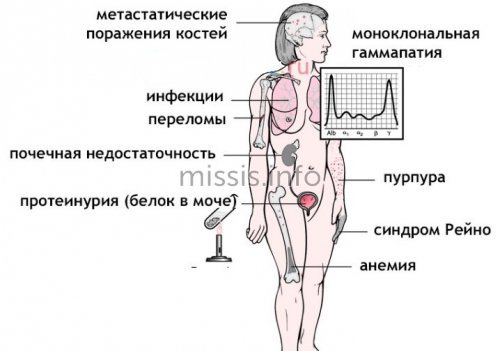
Hereditary bone marrow pathologies can also lead to thrombocytopenia. For example, the May-Hegglin anomaly. This disease is accompanied by a genetic mutation, which results in a deficiency of megakaryocytes and a decrease in the concentration of platelets in the blood.

